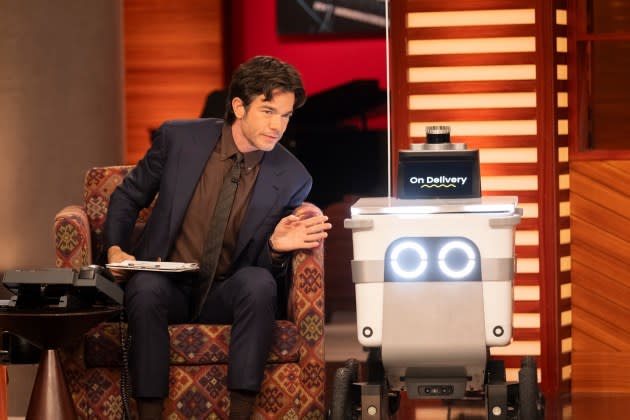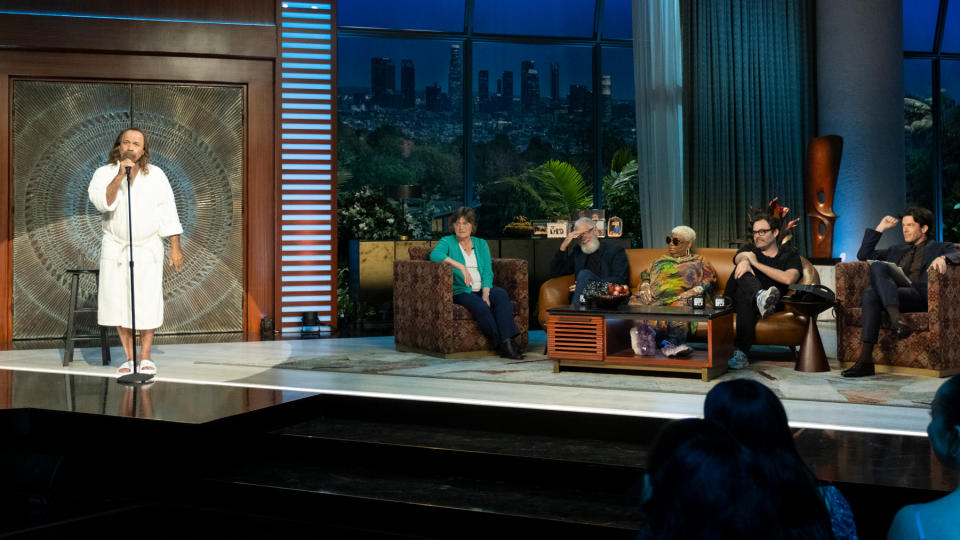Everybody’s Obsessed With ‘Everybody’s in L.A.’

Throughout the six-episode run of Netflix’s Everybody’s in L.A., John Mulaney’s comedian guests kept trying to find ways to describe the live talk show’s chaotic-bordering-on-surreal atmosphere. “I feel like this entire show is a Banksy!” a confused Jon Stewart suggested. Nikki Glaser perhaps explained it best, by telling Mulaney, “It’s like an inside joke that only you are in on.”
That line applies just as well to Mulaney’s delightful 2019 Netflix special John Mulaney & the Sack Lunch Bunch. Both then and now, the comedian demonstrates simultaneous affection for and mockery of classic Seventies and Eighties TV genres — feel-good public television specials for kids with Sack Lunch Bunch, and ramshackle Tonight Show With Johnny Carson episodes with Everybody’s in L.A. At times, these experiments feel like a close, loving approximation of the genuine article. (Mulaney’s new, much-commented-on longer hairstyle even looks like it belongs on someone sitting in between Carson and Burt Reynolds.) At others, they expertly spoof familiar tropes. And then there are the bits that transcend parody altogether to feel like hallucinations, like the gag in a late episode of L.A. where actor Kevin Gage reprised his role as sociopath killer Waingro from the 1995 movie Heat, only doing bad stand-up in a terrycloth bathrobe for Mulaney’s baffled studio audience, while celebrity guest Bill Hader was laughing so hard he could barely stay upright.
More from Rolling Stone
Ali Wong Opened Up About Her Divorce, Dating Bill Hader at Sold-Out Comedy Show
Richard Gadd Doesn't Want You to 'Sleuth' Real-Life 'Baby Reindeer' Characters
Throughout the week-plus run of Everybody’s in L.A., Mulaney kept stressing the show’s live nature — announcing the time at the start of each show, taking calls from viewers at home, and, in the finale, sending two studio audience members out into Los Angeles to see if they could track down Red Hot Chili Peppers bassist Flea (one of several Gen X musical icons to appear) before the hour was up. Live TV is an increasingly huge deal in the business, one of the few ways to get a mass audience to show up for something right when it debuts. Sports is the biggest draw, which is why rights deals for football, basketball, and baseball are all being split up among various broadcasters, cable networks, and streamers. Even sports-adjacent live programming, like Netflix’s Tom Brady roast, can seemingly do very well.
Going live with Everybody’s in L.A. was Netflix’s latest attempt to crack a genre that’s eluded every streamer so far: the late-night talk show. We’ve seen lots of talented people, most of them with late-night bona fides, try it and fail: Amber Ruffin, Chelsea Handler, Michelle Wolf, and Joel McHale, among others. In a few cases, streaming talk shows have gone away for political reasons, like The Problem With Jon Stewart and Patriot Act With Hasan Minhaj. But it’s easy to wonder if Apple and Netflix, respectively, would have left Stewart and Minhaj alone had their programs been pulling in bigger audiences.
To a degree, every talk show is now a streaming show: Last Week Tonight goes up on Max at the same time each new episode debuts on HBO, and non-night owls can watch Seth Meyers or Jimmy Kimmel the next day on Peacock or Hulu. But those series still have linear TV roots, and in most cases have conditioned audiences to make them a nightly or weekly habit since long before those viewers cut the cord. Streaming subscribers, though, have on-demand brain, and watch all but the most essential programming days, weeks, months, or even years after it’s first available. And talk shows that are topical — both in the jokes the hosts tell and in the projects their guests are promoting — just don’t play as well if you come to them well after the fact.

Among the many funny aspects of Everybody’s in L.A. is how completely unstuck in time it was, despite each episode debuting live. The show was linked to a current event, in that many of the guests were available because they were in town for the Netflix Is a Joke comedy festival. Mostly, though, Mulaney gathered his guests together for discussions of larger L.A. themes, like palm trees, news helicopters(*), and earthquakes. The comedians were joined by experts on those subjects. Sometimes, the gambit worked beautifully, like when David Letterman gradually took over Mulaney’s questioning of seismologist Dr. Lucy Jones. Other combinations were more awkward — Sarah Silverman seemed completely at a loss for how to participate in a discussion of the paranormal — but even that could be memorable. And, in general, having lots of guests onstage at once (like Carson used to, and like Graham Norton still does) created a livelier and more spontaneous atmosphere than when a guest is one-on-one with a host, going through the anecdote they discussed with a segment producer earlier in the day.
(*) Maybe the most surprising discovery of the week: O.J. Simpson prosecutor Marcia Clark had never before met Zoey Tur, the helicopter pilot who famously was first on the scene for the infamous low-speed chase with Simpson and the LAPD. You would think the two would have been on some kind of retrospective panel about the trial over the past 30 years.
While there were some references to current and upcoming events — palm trees are on the mind of Angelenos, for instance, because many of them may need to be replaced before the 2028 Summer Olympics come to town — nobody was there to plug a movie or show, and very little of the comedy felt like it had an expiration date. A few months or even years from now, you could watch for the first time any bit involving the hilarious, shameless Richard Kind as Mulaney’s sidekick — say, Kind suggesting insane party-starter questions like, “Have you ever gone down on a relative?” — or see film producer Brian Grazer regaling a roomful of elementary schoolers with stories about screenwriters Lowell Ganz and Babaloo Mandel, and it would be just as funny as it was for those who saw it live last week.
In that way, Everybody’s in L.A. has more in common with a Netflix travel series like Somebody Feed Phil or a scripted show like Russian Doll than with the streamer’s earlier talk-show attempts. It can endure in the Netflix library forever and always be worth discovering.
It also seems very much worth Netflix’s time to figure out if it can get Mulaney to do Everybody’s in L.A. as more than just a stunt. Producing and hosting a talk show is an all-consuming job, Mulaney is as hot and as in-demand as any comic right now, and the particular confluence of talent that allowed him to have Letterman, Hader, Cedric the Entertainer, and Pete Davidson all onstage on the same night wouldn’t be there in normal weeks. But it might be manageable if he were to make it as a periodic thing, whether one show a month, or a burst of five or six shows every few months. And, frankly, there’s so much more story to tell about Kind’s feud with Saymo the delivery cart robot, it would be a shame to cut it off here.
Best of Rolling Stone
